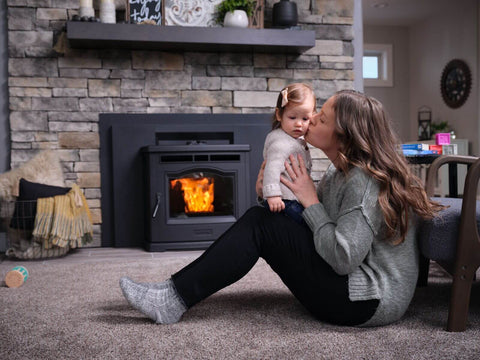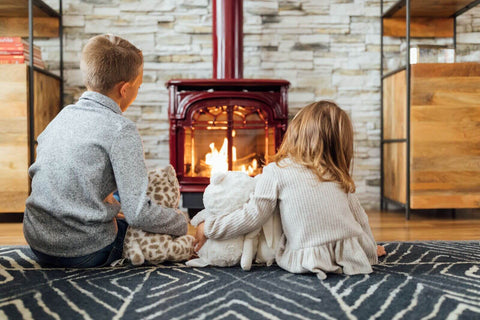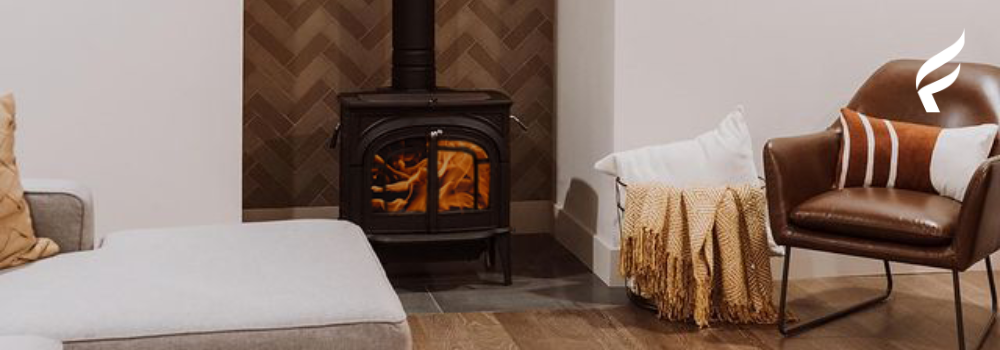Imagine a winter where your home glows with warmth without your heating bill sending chills down your spine.
Embrace the budget-friendly warmth of zone heating. With this approach, you're not just heating your home; you're crafting a haven of warmth all season long. Say goodbye to the dread of winter bills and hello to a comfortable sanctuary.
In this article, we will explore what zone heating is, the benefits of efficient heating, and factors to consider when choosing your home heating solution.

Get to know Forge & Flame and how sustainable heat can bring comfort and peace of mind to your home.
What Is Zone Heating?
Zone heating, sometimes known as zoned heating, directs heat to areas of your home where it's needed while reducing heat in less frequently used spaces such as unused bedrooms, storage rooms, and mudrooms. This approach is especially popular for people with large homes in cold climates.
By concentrating heat in your most-loved living areas, your stove efficiently warms a more defined zone, leading to significant savings on fuel and heating expenses. Adopting zoned heating can save up to 40% on heating bills.
How Zone Heating Works
When considering zone heating, focus initially on the spaces where you and your family spend most of your time—these areas should be your primary target for heat concentration.
You can enhance the efficiency of zone heating by ensuring your home is well-insulated. Conducting a home energy audit will identify the parts of your home that may benefit from additional insulation, caulking, and door seals, as well as the potential upgrade to energy-efficient doors and windows.
Zone heating works best when paired with a highly efficient heat source, such as a pellet stove. These eco-friendly heating units use innovative technology and sustainable fuels to deliver reliable, ambient warmth precisely where it's needed.

Did you know the right stove in the right place can reduce your heating bill? Learn how oil heating vs. pellet heating can save you money.
Types of Zone Heating
Various home heating methods are compatible with zoned heating, each with its unique set of benefits and challenges. These types of zone heating range from common space heaters to wood burning and pellet stoves, fireplaces, or even the use of smart thermostats.
Electric Space Heater
Typically used with another primary heat source, electric space heaters offer the flexibility to zone heat the spaces you spend the most time. Because of their plug-and-play nature, electric space heaters are easy to move from one space to the next and require no installation.
However, they are not great for heating large areas because of limited heat output. They also require electricity which can increase your bill, and if left unattended, can pose a risk for fires.
Radiant Heating
There are three main varieties of floor heating: radiant air floors, electric radiant floors, and hydronic (water-based) floor heaters. Each system installs beneath flooring, typically tile or stone. Smart zone thermostats control the flow of heat and tailor to each specific area.
The benefits of radiant heating are that they are efficient and require little energy to maintain comfortable temperatures while eliminating cold spots to keep you cozy. They also require no regular maintenance and are whisper-quiet.
The challenge is that the heated flooring is expensive, often costing more to install than the price of a new construction home, making them less common in existing homes. The installation process is time-consuming and disruptive, and repairs can be difficult to resolve.
Wood Burning Stove or Wood Pellet Stove
Wood-burning stoves and pellet stoves offer a traditional and efficient method of zone heating, utilizing renewable resources to create warmth. These stoves work by burning wood logs or pellets, to generate heat that radiates into the living space.
These stoves are highly efficient at converting fuel into usable heat from the use of renewable resources and can lower heating bills and overall expenses thanks to the federal Biomass Tax Credit.
Regular cleaning and maintenance, size, and upfront costs of wood burning or pellet stoves can be intimidating, but the long-term benefits outweigh these factors.
Electric Baseboard Heater
Electric baseboard heating is a zone heating solution that provides warmth to individual rooms or areas within a home. It operates by converting electricity into heat through resistive coils, which then radiate warmth across a room.
These quiet heaters install with minimal disruptions to existing structures and provide consistent heat across the room, eliminating cold spots.
The challenges of electric baseboard heaters are that they are not cost-effective when used for long periods, and require a lot of space. Most importantly, they pose a greater risk to pets and children that might try to touch them.

Learn about the pros, cons, and costs of wood pellet stoves and how to know if it’s the right zone heating solution for you.
Hydronic (Hot Water) Baseboard Heater
Hydronic baseboard heaters warm a room by circulating heated water through pipes and into baseboard units, functioning similarly to radiators. This method allows for a more consistent and efficient transfer of heat, utilizing thermostats to control the heat of a space.The easy installation process prevents disruptions, and these quiet heaters are energy efficient because of the water's high thermal retention.
Alternatively, the initial setup and maintenance costs can be higher than other heating methods. Like regular baseboard heaters, hydronic baseboard heaters take up space and are a safety risk to pets and children.
Wood or Gas Fireplace
Wood and Gas fireplaces provide warmth and ambiance to specific areas within a home, but have a limited range of heat output. Gas fireplaces burn natural gas or propane, producing heat and a beautiful flame. With a quick start and adjustable heat output, fireplaces are easy to use and offer the appeal of a real flame. Gas fireplaces are especially low maintenance compared to wood fireplaces, without ash or creosote to clean.
When deciding if a gas fireplace is right for you, consider factors such as access to gas lines and gas prices, the desire for aesthetic appeal in addition to warmth, and installation costs.
Ductless Mini-Split System
A ductless mini-split system is a versatile zone heating and cooling system that operates without extensive ductwork using electricity. This makes it ideal for targeted, controlled area heating and cooling of specific areas. A ductless mini-split system allows for all and dual-zone heating with one furnace by using an outdoor compressor/condenser unit connected by small conduits to one or more indoor air-handling units. Utilizing a heat pump mechanism, it efficiently transfers warm air in or out of the home depending on the season.
Though it seems complex, installation requires minimal structural modification, making it ideal for homes without existing ductwork. This system is also quieter and energy efficient compared to traditional HVAC zoning systems while offering advanced filtration that reduces dust, allergens, and bacteria in the air. Unfortunately, it is unsuitable for colder regions and requires professional installation and regular maintenance at a higher cost.
Warm Air Furnace and Zoning Controls
A warm air furnace with zoning controls is an advanced system that delivers heated air through ducts, allowing for customized temperature settings in each zone. This system draws air in, heats it via a furnace, and then distributes it through a network of ducts.
Warm air furnaces work with smart thermostats for precise control over heating, require less energy, and can lower heating bills over time. The ductwork and technology integration contribute to significant installation costs and require regular maintenance, which can result in extended periods of system downtime.

Consider adding a wood-burning stove to your home. Find inspiration from the Forge and Flame gallery.
Benefits of Zone Heating
Homeowners can heat specific zones of their homes where and when it's needed using controlled heating and cooling systems, resulting in numerous benefits. This method is especially beneficial in homes with multiple levels, large square footage, or rarely used areas, as it avoids heating unoccupied spaces.
Energy Efficiency
By heating zones in a house rather than the entire house, zone heating significantly reduces wasted energy, contributing to a more sustainable household while saving money.
Cost Savings
As energy consumption decreases, so do the monthly heating bills. With increased efficiency, your heat source uses less fuel to heat less space. The savings can be significant, cutting annual heating expenses up to 30%.
Personalized and Improved Comfort
You know your home best. This customization directs warmth into heating zones where you need it most to ensure that each space maintains an ideal comfort level, enhancing the overall living experience.

Explore all Forge & Flame stoves to elevate the ambiance in your home and bring warmth to your space.
Targeted Heating
Targeted heating means delivering warmth precisely where needed, ensuring no wasted energy on unoccupied areas of the home. This specificity enhances the system's efficiency and effectiveness, leading to faster heating times in desired zones and more consistent temperatures. Warm zones typically include the living room, kitchen, and office spaces.
Reduced Wear on HVAC Systems
Zone heating paired with supplemental heating, such as a pellet or wood stove, can extend the life of HVAC systems by reducing the total operational burden. By heating only occupied zones, the overall demand on the system decreases, leading to less wear and tear over time.
This reduces maintenance costs and prolongs the system's lifespan, making it a cost-effective solution in the long run. The reduced strain on HVAC components means fewer repairs and replacements, offering long-term savings and reliability.
Flexibility
The flexibility offered by zone heating systems allows homeowners to adapt their heating needs to their lifestyles. Dividing the home into heat zones to accommodate changes in occupancy or usage means improved energy efficiency and increased comfort levels.
Environmental Impact
Zone heating positively impacts the environment by reducing the household's carbon footprint. Decreasing energy consumption directly results in fewer greenhouse gas emissions because burning less fuel heats the home. Zone heating is a step towards more sustainable living practices, showcasing how individual choices can have a significant positive impact.

Check out our wood stove buying guide to find the perfect zone heating solution for your home.
Challenges of Zone Heating
While zone heating offers numerous benefits, several challenges may deter homeowners from adopting this solution.
While there are many zone heating methods to choose from, each has unique benefits and considerations. Some factors include the complexity of installation, high upfront costs, ongoing maintenance challenges, limited impact in certain climates, and space limitations for the equipment.
Complexity of Installation
The complexity of installing a zone heating system can be significant, especially when retrofitting existing homes. This challenge involves integrating new equipment with the home's current HVAC system, requiring expert knowledge and potentially extensive modifications to ductwork or the installation of new venting and radiators for hydronic systems.
Overcoming this challenge usually demands hiring professional contractors experienced in zone heating setups, which can add to the project's overall cost. Some of the most complex systems include radiant heating, a ductless mini-split system, or a warm air furnace.
Despite the intricacies, the long-term benefits of enhanced comfort and energy efficiency can justify the initial hurdles for many homeowners. Fortunately, alternative options like heating stoves and fireplace inserts do not require intricate or invasive renovations.
Upfront Costs
The initial financial expenditure to install a zone heating system is often considerable. Costs can vary widely depending on the type of system, home size, and installation complexity. On average, homeowners might expect to spend several thousand dollars on a comprehensive zone heating solution.
Although these costs are daunting, various financing options, rebates, and incentives can help mitigate the financial burden. Moreover, the potential for reduced energy bills through more efficient heating can offset these upfront costs over time.
Maintenance Challenges
Maintaining a zone heating system can present unique challenges, particularly as the system ages. Each zone's controls and mechanisms may require regular checks to ensure proper function, adding layers of complexity to routine maintenance.
Additionally, potential issues like leaks in hydronic systems or blockages in duct systems can impact system efficiency and comfort levels. Homeowners need to establish a regular maintenance schedule with professionals to avoid these issues, which can add to the total cost of ownership.
Being proactive about maintenance can prevent costly repairs and extend the system's lifespan. Owners of wood and pellet stoves can easily perform weekly, monthly, and annual maintenance tasks or delegate them to a local dealer or chimney sweep.
Limited Impact Depending on Climate
The effectiveness of zone heating can vary significantly depending on regional climates. In areas with mild winters, the cost and complexity of installing a zone heating system may outweigh the benefits, given the limited need for heating.
Conversely, in regions with harsh winters, the benefits of targeted heating and energy savings are more pronounced. Homeowners in temperate climates may find that simpler, less costly heating solutions meet their needs just as effectively. Assessing the local climate and heating requirements is crucial before investing in a zone heating system.
Space Limitations
Implementing a zone heating system in homes with limited space can be challenging. The installation may require additional equipment such as boilers, heat pumps, or multiple thermostats, which require space that may not be available in smaller homes or apartments. To overcome these constraints, you'll often need creative solutions, such as using wall-mounted units or integrating systems within existing structures, and careful planning.
Despite these challenges, the flexibility of modern zone heating technologies allows for adaptation to a wide range of home layouts and sizes, ensuring most homeowners can enjoy the benefits of customized heating.
Forge and Flame Wood Burning Stoves Offer Better Heating and Greater Comfort in Any Home
Zone heating represents a transformative approach to home heating, offering numerous benefits that extend far beyond comfort. Forge & Flame stoves and inserts focus heat where it's needed most, reduce unnecessary energy consumption, and tailor comfort to each homeowner's unique living space, making them an ideal choice for those seeking both efficiency and ambience.
Forge & Flame stands out from other brands because of its commitment to quality, sustainability, and innovative design. We engineer our wood-burning and pellet stoves to provide superior warmth, efficiency, and ease of use, setting a new standard for what homeowners can expect from their heating solutions. Forge & Flame offers options suited for a wide range of homes and preferences, ensuring that the warmth of your home matches the degree of our commitment to your satisfaction.
The choice of how to heat our homes becomes more than a matter of comfort—it's a statement of our values. With Forge & Flame, homeowners are choosing a path that leads to greater comfort, savings, and a more sustainable world. Explore our range of products and discover how we can help transform your home into the cozy, cost-efficient haven you deserve.






